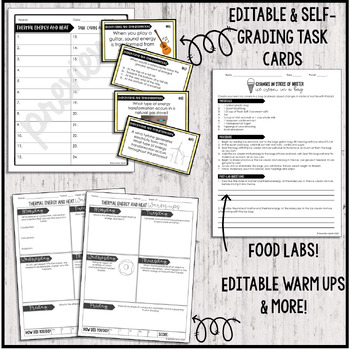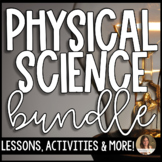Heat and Energy Bundle - Editable and Google Slides™
- Zip
- Google Apps™

Products in this Bundle (15)
showing 1-5 of 15 products
Also included in
- Save over 20% with this resource that includes all of my physical science activities including PowerPoints, Guided Notes, Assessments, Warm Ups, Self-Grading Task Cards, Choice Boards, Interactive science notebook Google Slides and Print Activities, Labs, Stations activities, project-based learningPrice $266.00Original Price $332.50Save $66.50
Description
This energy unit bundle includes many activities for a energy and unit in your physical science classroom covering conduction, convection, radiation, energy transformations and the Law of Conservation of Energy. Activities include PowerPoint lessons, guided notes, assessments, warm ups, task cards, choice boards, digital Google Slides/print activities, stations and any of my future activities for matter will be included.
All the activities are editable except for the digital Google Slides activities. Google Slides or Forms versions of each activity are included.
For each unit, the following are included:
- PowerPoint (with a Google Slides version) - editable
- Guided Notes (with a Google Slides version) - editable
- Assessment (with a Google Slides version)- editable
- 24 Task cards (with a self-grading Google Forms version) - editable
- 2-3 weeks of Warm Ups (with a Google Slides version) - editable
- Choice Board (with a Google Slides version) - editable
- Digital Google Slides& Print Activities
- Stations Activities - editable
Also Included:
- Create an Instrument Sound Waves Project-Based Learning
- Energy Transformations CER Stations Lab.
- S'mores Heat Transfer Lab
Content covered:
⭐What is energy?
⭐Types of Potential Energy
⭐Types of Kinetic Energy
⭐Energy Transformations
⭐Law of Conservation of Energy
⭐Kinetic Theory of Matter
⭐Temperature
⭐heat
⭐Thermal Energy
⭐Transfer of Heat
⭐Conduction
⭐Convection
⭐Radiation
*All resources, besides the Google Slides and Print Activities are text editable. Clip art and fonts are not due to copyright.*






